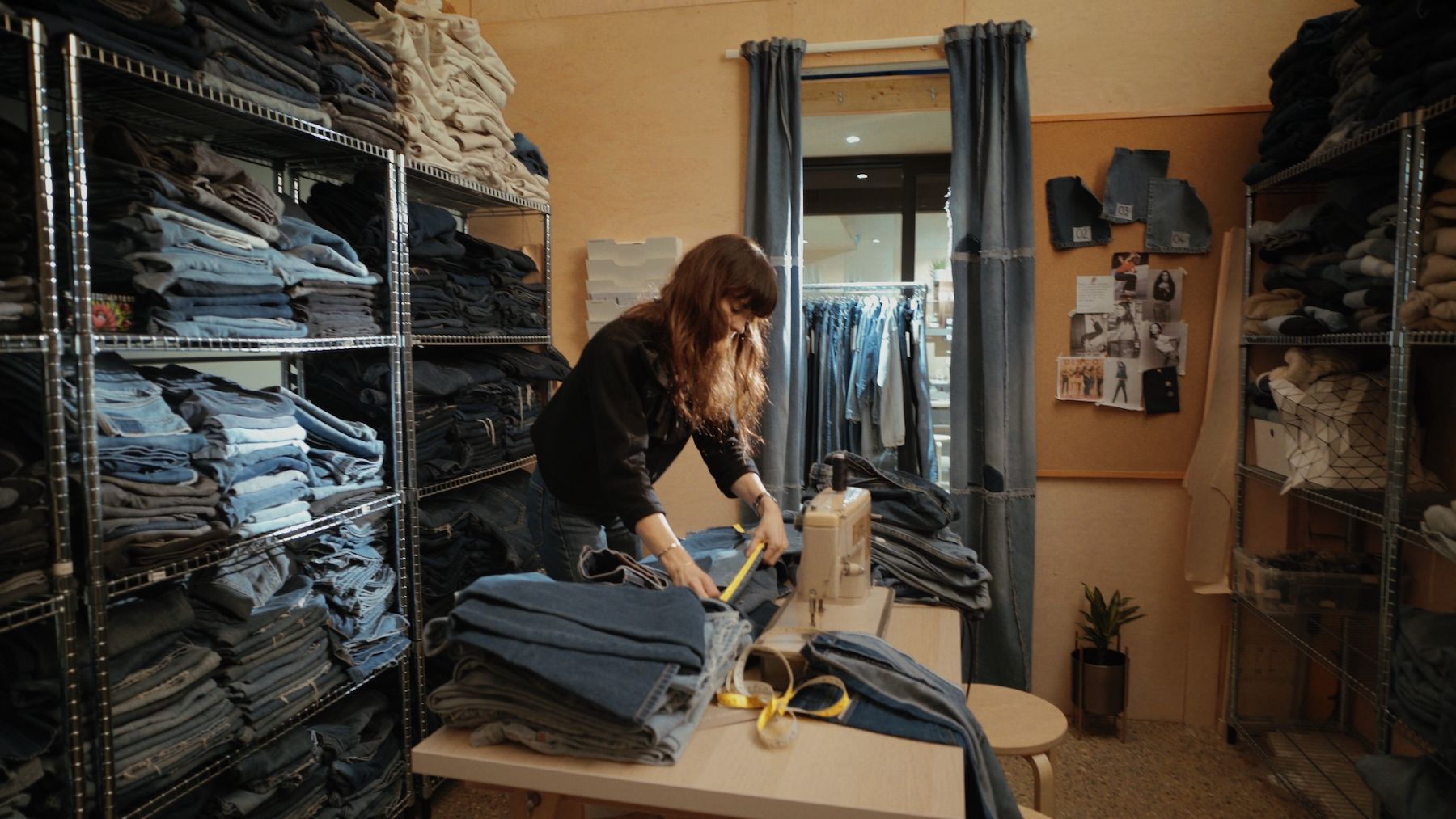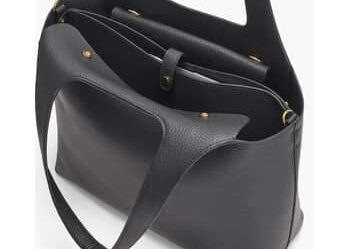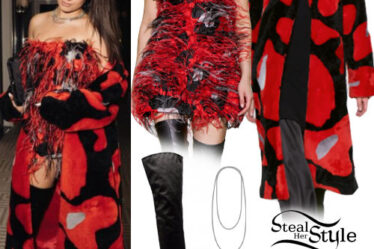
Late in August, Anna Foster is standing in front of me in her studio in Dalston, London contemplating the future of a pile of old jeans. “This could be a boyfriend or a flare,” says the founder and creative director of upcycled denim brand E.L.V. Denim, picking up a pair of jeans that’s been neatly labelled with a complicated code of letters and numbers indicating key measurements and quality attributes.
The code reflects a carefully crafted upcycling system that relies on painstaking hours of manual sorting to identify damage or stains on the supply of used denim that arrives in Foster’s studio — piece by piece or by the bale. Each garment is graded according to its condition and size, data points in a complicated matrix that determines each item’s suitability as a component for any number of styles.
The former cast-offs leave the studio transformed into hand-crafted jeans, jackets and jumpsuits sold at retailers including Bergdorf Goodman and Neiman Marcus starting at £250 ($306) a pair.
“It’s considered an ugly duckling,” says Foster. “[But I] know, it’s going to be a swan.”
The former stylist is among a small, but determined group of designers working to prove out a business model many consider impractical, if not impossible to scale: reworking a fraction of the millions of tonnes of old clothes tossed away each year into something more desirable than when they were new.
Though upcycling is increasingly fashionable, it’s also fiendishly difficult to operationalise. Instead of the blank canvas offered by a roll of fresh fabric, reworking old clothes means grappling with a hodgepodge of materials of varying shapes and sizes that have already been cut and sewn to fit a specific purpose. It’s a process that’s time-consuming and tricky, which is why even as more emerging designers, from Marine Serre to Connor Ives, have gained acclaim for collections crafted from repurposed vintage clothing, they’ve typically had to diversify their approach as they’ve sought growth.
It’s something Foster refuses to compromise on. Instead, she’s spent six years perfecting her system of upcycling to efficiently turn old clothes into pattern pieces. Though it remains small, E.L.V. Denim is profitable and fast-growing: sales are expected to double this year and are projected to exceed £1 million in 2024.
“I’ve discovered a problem and I’ve created a beautiful solution,” says Foster. “People roll their eyes at sustainability now; I want people to come to me for handcrafted, upcycled luxury.”
‘A Beautiful Solution’
Foster launched E.L.V. Denim in 2018 with £1,500, a single style and an iron-clad principle: that good quality material trapped in unwanted clothing should not be going to waste.
Her first collection was picked up by Net-a-Porter and sold out. The brand has grown from there with the help of grants from the British Fashion Council and the UK’s national innovation agency and funding from angel investors amounting to several hundred thousand pounds.
The brand now sources around 10,000 pairs of used jeans a year, prioritising damaged and XL sizes that are not typically in demand on the resale market. Foster estimates she’s stopped roughly 45,000 jeans from going to landfill in the six years since launching. Her products are designed to have lasting value, taking aim not only at the challenge of excess old clothes, but its root cause: the increasingly fast churn of fashion consumption.
To be sure, Foster’s way of working requires time up front to sort, grade and pair old garments for new designs. Collections are defined by the material the brand is able to source, rather than the other way around. But there are savings and efficiencies too: there’s no sampling and because every item is unique and made in small batches, there’s no waste.
It’s a disruptive approach tied to Foster’s conviction that the last thing the fashion industry needs is more new stuff. And it challenges the core of the sector’s standard operating model.
“It takes more time to rescue the material,” says Foster. “It’s really hard; that’s why no one else does what we do.”
A Complicated Supply Chain
It’s October and pouring with rain when my train from London pulls into Hull, a port city about two-and-a-half hours north of the capital and homebase for the Vintage Wholesale Company, one of a handful of suppliers across the UK that Foster regularly mines in a hunt for the right mix of unwanted jeans, cotton shirts, silk scarves and other materials needed to serve whatever collection is currently in the works.
Amongst other things, today the creative director and her team are on the hunt for an emergency supply of denim jackets after a delivery went missing in the post. Replacements are needed urgently for an upcoming launch with British retailer Liberty. The team asks a barrage of questions before every sourcing trip to try and make sure what they need is what’s in stock, but ultimately they never know exactly what they’ll find.
It’s an unpredictable, complicated and opaque supply chain, even for fashion. But one constant is the sheer volume of clothes available as consumers churn through their closets at an accelerating pace.
Riccardo Seaton, the Vintage Wholesale Company’s owner, knows this first-hand. He started selling used clothes as a hobby, buying up vintage items by the kilo and selling them on eBay in the mid 2000s. Now he says he imports up to 50 tonnes of vintage clothing a month from a specialist supplier in Europe (almost all of the estimated half a million tonnes that British consumers deposit into the secondary market every year are sent straight out of the country for manual sorting in places with lower labour costs). In nearly 20 years in the business there’s been plenty of change, with the rise of a wider variety of resale platforms and popularisation of vintage and upcycling spurring competition. But the amount of stuff cycling through wardrobes these days has more than kept up with resale demand.
“There’s just so much,” said Seaton.
At 10:30 in the morning, the Vintage Wholesale Company’s warehouse is already bustling with some dozen people picking through neat lines of woven plastic bales. A bag stuffed full of fair isle sweaters spills its guts to a vintage hound in an orange and blue fleece vest. Nearby, a bale filled with glitter-woven lurex dresses neighbours a stash of leather jackets. Abba is on full blast over the sound system.
Foster is in a corner systematically sorting through piles of jeans, fastidiously separating out pairs with blemishes or from brands that perform poorly on the British resale market.
“People are taking good quality things and then kind of unnecessarily reworking them,” she says. “I’ll take the damaged stuff.”
Scaling the System
Back in Dalston, neat packets of denim are already stacked on shelves, meticulously labelled with instructions for their final shape: a duo of old jeans in contrasting colours is destined to become a pair of E.L.V. Denim’s signature two-tone trousers; a bigger package is intended to become panels for a patchworked jumpsuit; a mix of distressed and damaged denim is listed for slicing into strips that can be used to form pleats for a dramatic denim cape.
Foster says the system is ready to scale, with an eye on new supply chains and broader partnerships to help other brands manage old and unwanted products. This year, she negotiated an agreement with Soho House Group to incorporate old bed linen from their hotels into her supply chain. The first collection of ruffled shirts, dramatic collars and nipped-waist skirts was made of cotton sheets from The Ned Hotel in London.
To be sure, there are still hurdles. Not least the traditional demands of wholesale partners, who are poorly set up to handle collections where every item is unique. Foster now ships her denim — designed with uneven hems that highlight the original shape of the jeans that went into them — with the cuffs rolled up so they all appear uniform on the shop floor.
Her aim is for the product to speak for itself; she has no interest in being labelled as just another sustainable brand. The goal is to make the solution more desirable than the source of the problem: “If we are going to make change we have to stop fast fashion culture,” Foster says.


